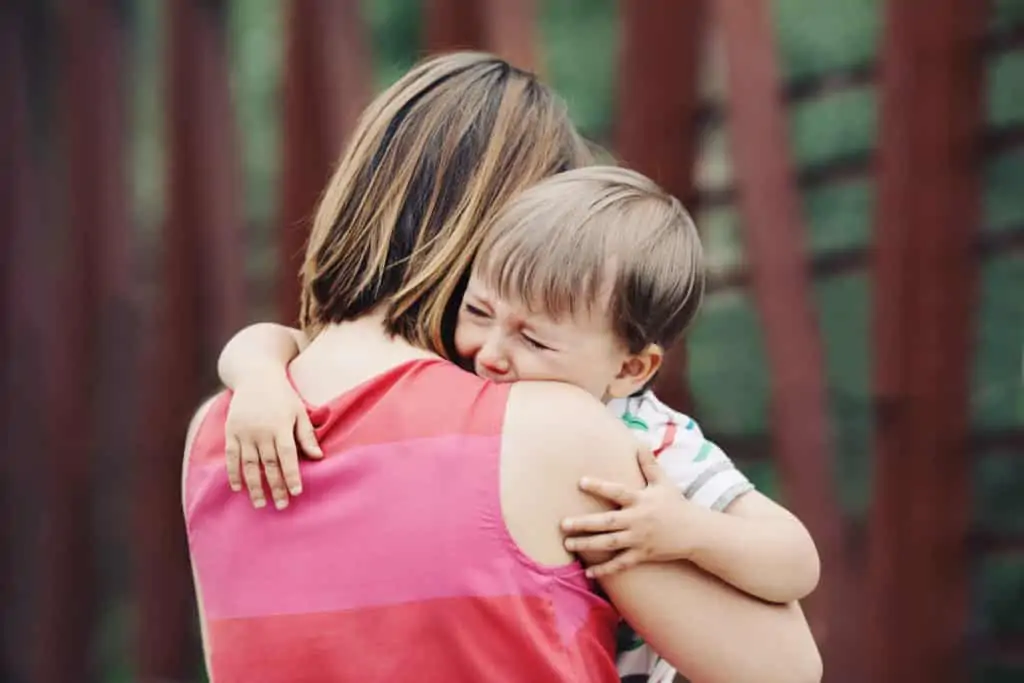How to help your child identify their feelings and build emotional intelligence by learning to appropriately express their emotions. Teaching children to identify what they’re feeling and what prompts them to feel these emotions, how to problem solve solutions and act appropriately. Try the Emotions Identification Bundle to help support your child in learning, naming, and communicating their feelings and deep dive into what’s going on, on the inside.

Help Children Identify Emotions & Express Their Feelings in Healthy Ways
As adults, we’ve had many, many years to learn how to process our emotions and express them in respectful, non-explosive ways. Little children on the other hand, haven’t had decades of experience, and developmentally, aren’t able to slow down and process their thoughts before they escalate into turbulent reactions.
It’s up to adults to help little ones learn how to process what they feel without tantrums and explosive behavior, but calmly and as appropriately as possible.
Learn how to be the emotional coach your child needs so they can learn how to manage big feelings and resolve their feelings.
Want Help Supporting Your Child’s Big Emotions? Check Out These Resources:
1. Model Calm Behavior
When your child is becoming worked up, or your own nerves feel frayed, it’s important to calm yourself before you react so you can model calm behavior for your child . If children are to learn how to pause and react without anger, you have to show you’re a patient Mom.
- Stop what you’re doing to ensure your focus is entirely on your child, take a deep breath or use your preferred calming technique whether that’s taking a moment in the bathroom to yourself or squeezing a stress ball, find your calm and then respond when you can do so peacefully.
- Take a 10 second pause to remind yourself to be the calm adult so you don’t escalate your child’s reaction.
- Remember, this is a teaching opportunity to demonstrate the type of behavior and reaction you want to see from your child. They are here to learn from you!
- Don’t take your child’s emotions personally – their feelings and tantrums aren’t about you, but the mixed feelings they’re trying to untangle inside.
2. Respond with Empathy
Your child’s emotions are tangled right now as the storm inside of him brews. Developmentally, little ones are unable to process why they feel the way they do, and can’t make the connection about what caused it and the reaction they feel.
For example, when big brother takes the book he’s been reading, he lashes out by hitting him. While an adult sees the child is upset because the book he was reading was taken without permission, the cause and reaction is clear. However, to a child, they are filled with complicated emotions of sadness, anger, and hurt but doesn’t know the name to these emotions and why he feels them. It’s confusing!
This is where the adult steps in by responding with empathy.
- To stop the reaction from escalating, use a calm and empathetic tone when talking to your child.
- Get down to their level so you are on the floor with them or squatting to match them eye-to-eye. This creates connection and a safe place for them to open up.
- Make your child feel safe by using a warm tone, gentle touch and empathetic approach.
3. Help Them Untangle & Name Their Emotions
Children aren’t born with emotional intelligence – the ability to communicate their feelings once they recognize those feelings –it’s developed over time, with an adult’s assistance.
Emotional intelligence sounds like this:
“I feel ______ because ______” type of statements.
- Play back the scenario for your child naming the cause and reaction.
- This helps them understand their feelings and properly put a name to what they feel inside, but also makes them feel seen and heard.
- For example, “You look sad because your sister took your favorite stuffed animal without asking. Is that right?”
- Describe the problem to your child and name the emotion as you respond to them.
- If your child is old enough to explain this situation, ask them to describe what happened and prompt them to explain their feelings so you can help them put proper names to their emotions.
- Repeat what you hear back to your child to validate their emotions. For example, “I think I understand. You feel angry because your brother sprayed you with water and you didn’t want to get wet. Does that sound about right?”
Try the Emotions Identification Bundle to help support your child in learning, naming, and communicating their feelings and deep dive into what’s going on, on the inside.
4. Playback the Situation To Gather More Information
When you playback what your child has said about their feelings or end your observation of their emotions with a question, you ask for their input and help them expand the conversation, especially if the emotion stated is incorrect.
For example, if you say one of these phrases after you state / repeat the cause and reaction:
- “Does that sound right?”
- “Is that what you’re trying to tell me?”
- “I heard you say you’re sad your brother took the toy you were playing with. Am I hearing this right?”
If you thought your child was sad, but in fact, they’re embarrassed, this opens the door for them to correct the emotion and tell you what actually made them feel embarrassed.
It’s important to let your child be honest about what they’re feeling. If they insist they’re mad, even though you may disagree or see the situation differently, let them feel mad, and acknowledge that feeling. Push your own feelings aside.
The validation you offer them is more important than being right.
5. Create a Safe Environment to Talk About Feelings
Children feel safe to acknowledge their emotions when they live in an positive environment where adults can recognize and express their own feelings.
When you’re stressed about running late to school in the morning, or feel annoyed that no one is cleaning up their mess around the house – use the same cause and reaction statements.
- “Mommy is stressed right now that we’re late to school.”
- “I’m starting to get angry because I’ve asked you to clean up after yourself, but you haven’t done it.”
- “Mommy really wants to go for a walk, but she’s frustrated your toys are still all over the floor.”
You also create a safe environment for your child by responding with comfort and making them feel OK to open up. Whether your child is angry or in tears, it’s remarkable how much offering your comfort sets the tone for positive interactions to follow.
Ask if they want a hug and see how quickly they run into yours arms before talking about their feelings.
Let little ones know it’s OK to express themselves with helpful phrases such as:
- “Everyone feels angry sometimes.”
- “It’s Ok to cry, sometimes we need to just get it all out.”
- “I noticed every time you’re worried, you bite your fingernails and you’re doing that right now. Is there anything you want to talk about?”
- “I’m right here, whenever you need me.”
- “You’re safe.”
- “You seem so upset, do you want to talk about it?”
- “I can see from the way you’re crossing your arms and are stomping your feet, that you must be really angry. Tell me what’s going on.”
- “I see how upset you are. What can I do to help?”
Validating your child’s feelings will encourage them to tell you more. You may not agree or fully understand what they’re feeling, but by supporting your little one, you’re deepening your connection and helping them feel like they can talk to you freely.
6. Move Towards Problem Solving Solutions
When little kids become familiar with their emotions and what causes them to react the way they do, the opening to help them work through problem solving solutions becomes the next step in building emotional intelligence.
The tricky piece of this step, is to help prompt your child to problem solve without giving away the farm. Encourage kids to find solutions on their own with prompts.
For example, when your son says “I’m mad, mad, mad! Sissy took the scissors I was using for my project without asking and I need to use them.”
You can respond with any of these problem-solving prompts to help him find a solution:
- “Hmmm, how do you think you both could use the scissors without fighting over them?”
- “Gosh, I wonder if there’s a way you could both use them for your own art projects. What do you think?”
- “I see how that can make you mad, but I love how you’re both working hard on your art and the scissors are an important tool to cutting all those shapes. How could you both use them to finish your projects? What do you think?”
Find help with the Calm Down Toolkit with self-regulatory techniques kids can choose from including mindful breathing patterns, affirmations and more.
Recap: Help Your Child Express Big Emotions
Remember, stay calm when you see the storm brewing with your little one and then move through the steps of comfort.
- Help your upset child recognize the key emotion and what prompted the reaction.
- Playback the cause and reaction to see if your child has additional input or is feeling a different emotion.
- Validate their feelings and if the space allows, prompt them to find a solution to the problem on their own.
The more you practice these steps to helping your child express their big emotions, the easier they will become.
Recommended Books on Big Emotions & Feelings:
Additional Helpful Parenting Resources
- Parents: 5 Steps to Teach Kids How to Manage Big Emotions (Free Printable)
- Handling Toddler Tantrums: Big Emotions & Helping Your Toddler Feel Heard
- Helping Kids with Transitions: Switching Gears without Tears
- Parenting Mindset: How You See Your Child on Hard Days Affects Your Relationship
- How to Stay Calm When Your Child Misbehaves
Want even more?
Shop All Parenting Resources
Shop all of our parenting resources from self-regulation tools and managing big emotions to building self esteem and confidence. There are resources for all seasons of life!















